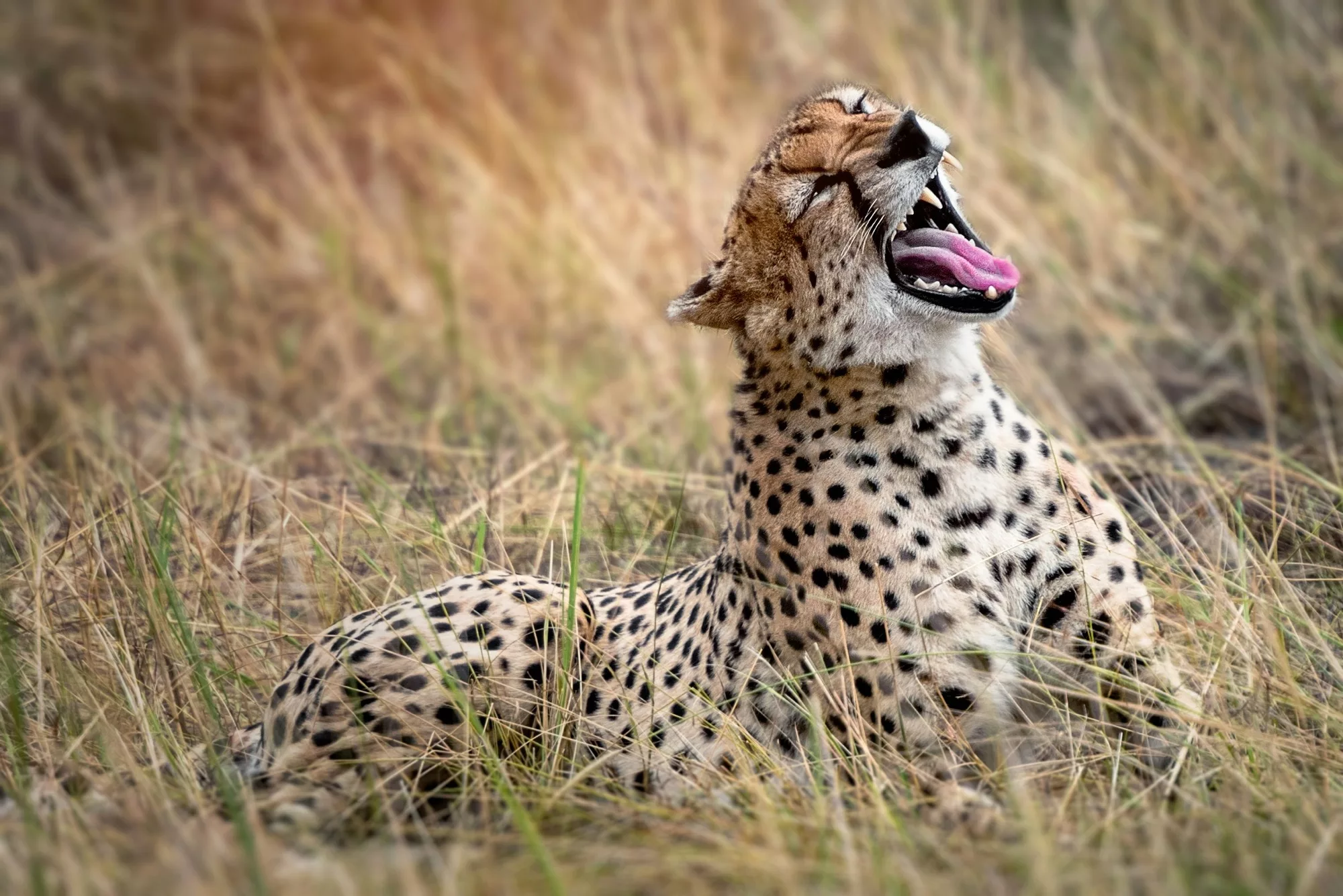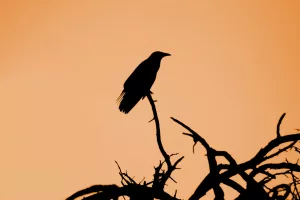Cheetahs (Acinonyx jubatus), the fastest land animals on Earth, are iconic symbols of speed, agility, and grace. Their slender bodies, powerful legs, and distinctive black tear marks make them one of the most recognizable and fascinating members of the big cat family. However, there’s far more to cheetahs than just their impressive speed. These incredible creatures possess a unique set of adaptations and behaviors that set them apart from other predators in the animal kingdom.
In this article, we’ll explore 16 remarkable facts about cheetahs that reveal their evolutionary advantages, their ecological importance, and the challenges they face in the wild. By understanding these facts, we can gain a deeper appreciation for the cheetah and its role in maintaining the balance of our ecosystems.
1. Cheetahs Are Built for Speed
Cheetahs are renowned for their ability to reach incredible speeds of up to 60–70 miles per hour, making them the fastest land animals. Their bodies are perfectly designed for high-speed chases, with long, muscular legs, lightweight frames, and flexible spines that allow them to stretch their bodies to maximum length during each stride. They can accelerate from 0 to 60 mph in just a few seconds, rivaling some of the world’s fastest sports cars.
The cheetah’s tail serves as a counterbalance during high-speed pursuits, helping them make sharp turns while chasing prey. Their semi-retractable claws provide extra grip, acting like cleats on a track, while their large nasal passages and lungs ensure maximum oxygen intake during sprints. However, this extraordinary speed comes at a cost: cheetahs can only maintain their top speeds for short bursts, usually under 20–30 seconds, before they risk overheating or exhaustion. Their ability to reach and sustain these speeds is a marvel of evolutionary adaptation.
Despite their incredible acceleration and speed, cheetahs rely on stealth and strategy to catch prey. They often stalk their targets to get as close as possible before initiating a chase. This combination of physical prowess and calculated hunting tactics makes them one of nature’s most efficient predators.
2. Cheetahs Have Unique Black Tear Marks
One of the most distinctive features of cheetahs is the pair of black tear-like streaks that run from the inner corners of their eyes down to the sides of their mouths. These markings are not just for show—they serve a critical purpose in the cheetah’s survival.
The tear marks help reduce glare from the sun, improving the cheetah’s focus and precision during daylight hunts. This adaptation is especially important, as cheetahs are diurnal hunters, meaning they hunt primarily during the day to avoid competition with larger nocturnal predators like lions and leopards. The tear marks also enhance the cheetah’s vision, which is crucial for spotting prey from long distances.
Additionally, these markings may play a role in communication. Cheetahs use a range of visual signals, and the contrast provided by the tear marks could help other cheetahs interpret facial expressions, particularly in social or territorial interactions.
3. They Are Built for Agility, Not Strength
Unlike other big cats such as lions or leopards, cheetahs are not built for brute strength. Their slender frames and lightweight bones prioritize speed and agility over raw power. This means that while cheetahs are incredibly effective at catching prey, they are less equipped to defend their kills against scavengers or larger predators.
Cheetahs are highly specialized hunters, focusing on small to medium-sized prey like gazelles, impalas, and hares. Their hunting technique involves chasing their prey down and tripping it with a swipe of their paw before delivering a suffocating bite to the throat. However, once they’ve made a kill, cheetahs must eat quickly to avoid losing their meal to stronger competitors like hyenas or lions.
This reliance on speed over strength underscores the cheetah’s unique place in the ecosystem. Their specialized hunting abilities allow them to target prey that might otherwise escape slower but stronger predators, playing an important role in maintaining balance in their habitats.
4. Cheetahs Have Exceptional Vision
Cheetahs rely heavily on their keen eyesight to locate and track prey. Their vision is adapted for spotting movement from great distances, often exceeding three miles in open terrain. Unlike humans, who have a wide field of vision, cheetahs have forward-facing eyes that provide a narrower but more focused view, perfect for zeroing in on a single target during a chase.
Their excellent depth perception allows them to judge distances accurately, which is crucial when chasing prey at high speeds. This adaptation helps them calculate the timing of their final pounce with incredible precision. Additionally, cheetahs’ ability to see in color gives them an advantage in distinguishing their prey from the surrounding vegetation, even in the harsh sunlight of their typical savanna habitats.
This reliance on vision over other senses, such as smell, differentiates cheetahs from other big cats. While lions and leopards may use scent to track prey, cheetahs depend on their sharp eyesight and quick reflexes to succeed in their hunts.
5. They Are Not True “Big Cats”
Cheetahs differ from other big cats like lions, tigers, and leopards in several key ways, one of which is their inability to roar. Unlike true big cats, which belong to the genus Panthera, cheetahs belong to the genus Acinonyx. This classification reflects their unique anatomy and behavior, as well as their distinct vocalizations.
Instead of roaring, cheetahs communicate through a variety of sounds, including chirps, purrs, growls, and hisses. Chirping, a high-pitched call often used between mothers and their cubs, is particularly distinctive and sets cheetahs apart from other feline species. Their ability to purr, similar to domestic cats, further highlights their unique place in the animal kingdom.
This distinction also extends to their physical characteristics. Cheetahs have smaller, less muscular builds compared to true big cats, prioritizing speed and endurance over power. These differences make them one of the most specialized and unique members of the feline family.
6. Cheetahs Are the Most Endangered Big Cats in Africa
Despite their iconic status, cheetahs are the most endangered big cats in Africa, with fewer than 7,000 individuals remaining in the wild. Their population has declined dramatically due to habitat loss, human-wildlife conflict, and competition with other predators. Cheetahs require vast territories to roam and hunt, but urbanization, farming, and deforestation have fragmented their habitats, making it increasingly difficult for them to survive.
Human-wildlife conflict further exacerbates their challenges. Farmers often view cheetahs as a threat to livestock and may resort to killing them to protect their herds. Additionally, the illegal pet trade has taken a toll on cheetah populations, particularly in the Middle East, where owning a cheetah is seen as a status symbol. Cubs are frequently captured from the wild, leading to a devastating loss of future generations.
Conservation efforts are underway to address these issues, including habitat restoration, community education, and initiatives to reduce human-cheetah conflicts. Organizations like the Cheetah Conservation Fund (CCF) work tirelessly to protect cheetahs and ensure their survival for future generations.
7. Cheetahs Have a Unique Hunting Strategy
Cheetahs employ a highly specialized hunting strategy that sets them apart from other predators. Unlike lions or leopards, which rely on ambush tactics or sheer strength, cheetahs use a combination of stealth, speed, and precision to secure their meals. They are diurnal hunters, meaning they primarily hunt during the day, which helps them avoid competition with nocturnal predators like lions and hyenas.
A cheetah’s hunt begins with a stealthy approach, often crouching low and using cover to get as close as possible to its target. Once within range—typically 30–100 meters—the cheetah explodes into a sprint, using its incredible speed to chase down the prey. Their agility allows them to make sharp turns and sudden bursts of acceleration, matching the movements of their prey.
The chase is short-lived, rarely lasting more than 30 seconds. If successful, the cheetah trips its prey with a swipe of the paw and delivers a suffocating bite to the throat. Afterward, the cheetah must eat quickly to avoid losing its kill to scavengers. This efficient and precise hunting method highlights the cheetah’s specialization as a predator.
8. Cheetahs Have a Vulnerable Genetic Makeup
Cheetahs suffer from a severe lack of genetic diversity, a problem that has plagued the species for thousands of years. Genetic studies suggest that cheetahs underwent a population bottleneck during the last Ice Age, reducing their numbers to a small group of survivors. This event left the species with a very limited gene pool, which persists to this day.
As a result, cheetahs are more vulnerable to diseases, have lower fertility rates, and face challenges adapting to environmental changes. Their weakened genetic makeup also contributes to higher mortality rates among cubs, as they are more susceptible to illnesses and developmental issues. Conservationists are working to mitigate these challenges by preserving and expanding wild populations while promoting genetic diversity through carefully managed breeding programs.
9. Cheetah Cubs Face High Mortality Rates
Raising cheetah cubs is a daunting task for mothers, as cub mortality rates in the wild are alarmingly high. Up to 70% of cheetah cubs don’t survive their first year, primarily due to predation by lions, hyenas, and other carnivores. Cubs are born blind and helpless, relying entirely on their mother for protection and nourishment.
To improve their cubs’ chances of survival, mother cheetahs move their young frequently, often every few days, to avoid detection by predators. Despite these efforts, their vulnerability during early life stages remains a significant challenge for the species.
Human interventions, such as providing safe havens and reducing predator pressures, have helped improve survival rates in some areas. However, ensuring the long-term survival of cheetah populations requires addressing broader issues like habitat conservation and reducing human-wildlife conflict.
10. They Play an Essential Role in Ecosystems
Cheetahs play a vital role in maintaining the balance of ecosystems by regulating prey populations. As apex predators, they primarily target weak, sick, or young individuals, helping ensure healthier prey populations and preventing overgrazing of vegetation. This ecological service benefits not only the prey species but also the broader environment.
Cheetahs’ preference for smaller prey also helps reduce competition with larger predators, allowing multiple carnivores to coexist within the same ecosystem. Their presence supports biodiversity, as their hunting habits create opportunities for scavengers like jackals and vultures to access food. Protecting cheetahs is essential for preserving the delicate balance of the ecosystems they inhabit.
11. Cheetahs Can’t Climb Like Other Big Cats
Unlike leopards or lions, cheetahs lack the physical strength and retractable claws necessary for climbing trees. While they can jump onto low branches or elevated surfaces, their slim bodies and semi-retractable claws are not well-suited for climbing.
Instead of climbing trees to scout for prey or avoid predators, cheetahs rely on their keen eyesight and speed to navigate their environment. They often use termite mounds, hills, or other elevated terrain to gain a better view of their surroundings, compensating for their inability to climb. This adaptation reflects their specialization as ground-based predators, emphasizing speed and agility over physical power.
12. Their Purring Sets Them Apart
Cheetahs have a unique vocalization repertoire, with purring being one of their most distinctive sounds. Unlike lions and other big cats that roar, cheetahs communicate through a variety of chirps, growls, hisses, and purrs. Purring is particularly common between mother cheetahs and their cubs, serving as a comforting and bonding mechanism.
Cheetahs purr both when inhaling and exhaling, similar to domestic cats. This behavior occurs during moments of relaxation or contentment, such as when cubs are nursing or when adults are resting after a meal. Their vocalizations highlight the softer, more social side of cheetahs, offering a glimpse into their complex emotional and communicative lives.
13. Cheetahs Thrive in Open Habitats
Cheetahs are uniquely adapted to thrive in open landscapes, such as savannas, grasslands, and semi-arid deserts. These habitats provide the space they need to reach their incredible speeds while chasing prey. The wide, open terrain allows cheetahs to use their keen eyesight to spot potential targets from a distance, giving them a strategic advantage during hunts.
Unlike leopards, which prefer forested areas for stalking and ambushing, cheetahs rely on their ability to blend into the tall grasses and use stealth before initiating their high-speed pursuit. Their golden-yellow coats, dotted with black spots, offer excellent camouflage in these environments, helping them remain undetected by prey and predators alike.
However, habitat loss due to agriculture and urban development poses a significant threat to cheetahs. As open spaces are converted into farmland or settlements, cheetahs face increasing challenges in finding suitable areas to hunt, breed, and raise their cubs. Conservation efforts focused on preserving open habitats and creating wildlife corridors are essential to ensuring the survival of this iconic species.
14. They Are Solitary Yet Social
Cheetah behavior varies depending on gender and life stage, making them both solitary and social animals. Female cheetahs are typically solitary, except when raising their cubs. They dedicate their lives to nurturing and protecting their offspring, often moving alone through vast territories to find food and shelter. Their independence ensures they can focus entirely on their young without the distractions of group dynamics.
Male cheetahs, on the other hand, are more social and often form coalitions. These coalitions usually consist of brothers from the same litter and occasionally include unrelated males. By banding together, male cheetahs can defend larger territories and increase their chances of mating success. These groups exhibit remarkable cooperation, working together to hunt and ward off rivals, demonstrating that social bonds play a vital role in their survival.
The balance between solitary and social behaviors allows cheetahs to adapt to their environment and optimize their chances of survival. This duality adds another layer of complexity to their already fascinating lives.
15. Cheetahs Are Surprisingly Vocal
Cheetahs are highly vocal cats, using a variety of sounds to communicate with one another. Their chirping calls are among the most distinctive and are often used by mothers to communicate with their cubs or by males seeking a mate. These high-pitched sounds can travel long distances across the savanna, helping cheetahs stay connected even when separated.
In addition to chirping, cheetahs produce a range of other vocalizations, including growls, hisses, and yelps. Each sound serves a specific purpose, whether it’s warning off potential threats, expressing contentment, or signaling to coalition members. Their vocal repertoire is far more diverse than many people realize and reflects their need to communicate effectively in their open, social environments.
Unlike roaring big cats like lions, cheetahs lack the specialized larynx that enables roaring. Instead, their vocalizations are softer and more varied, aligning with their unique ecological niche and social behaviors. These sounds are an essential aspect of their survival and help maintain the delicate balance within their social and familial structures.
16. They Are a Symbol of Conservation
Cheetahs have become a global symbol of conservation, representing the urgent need to protect endangered species and their habitats. Their declining numbers and the unique challenges they face have made them a focal point for wildlife conservation efforts. Organizations like the Cheetah Conservation Fund (CCF) work tirelessly to raise awareness, implement conservation programs, and collaborate with local communities to ensure the survival of cheetahs.
These efforts include creating protected areas, reducing human-wildlife conflict through education and outreach, and developing innovative solutions like livestock guardian dog programs to prevent farmers from killing cheetahs. Additionally, captive breeding programs aim to maintain genetic diversity and reintroduce cheetahs into the wild.
Cheetahs’ plight highlights the interconnectedness of ecosystems and the critical role humans play in preserving biodiversity. By supporting cheetah conservation, we not only save an iconic species but also protect the habitats and other wildlife that depend on these ecosystems.
Conclusion
Cheetahs are extraordinary creatures, defined by their speed, grace, and unique adaptations. From their record-breaking sprints to their intricate social behaviors and vocalizations, these big cats embody the beauty and complexity of nature. However, their status as the most endangered big cat in Africa serves as a stark reminder of the challenges they face in a rapidly changing world.
Understanding the 16 remarkable facts about cheetahs presented here not only deepens our appreciation for their role in the natural world but also underscores the importance of conservation efforts. By protecting cheetahs and their habitats, we preserve the delicate balance of ecosystems and ensure that future generations can marvel at these magnificent animals. Cheetahs are not just a symbol of speed—they are a testament to resilience, adaptability, and the enduring power of nature.




